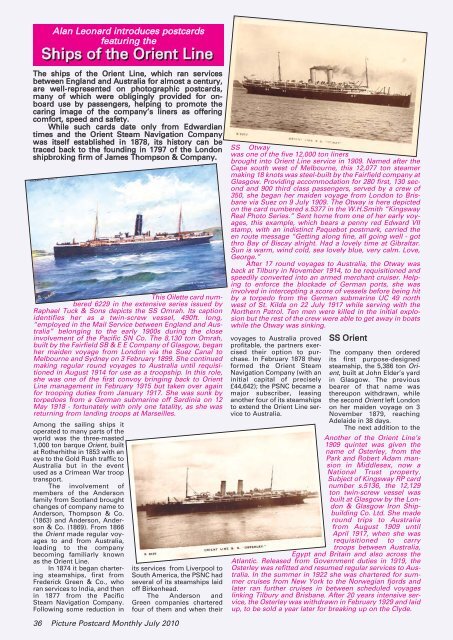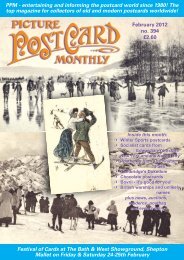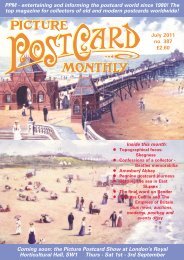PPM revisits Manchester's Belle Vue amusement park - Picture ...
PPM revisits Manchester's Belle Vue amusement park - Picture ...
PPM revisits Manchester's Belle Vue amusement park - Picture ...
Create successful ePaper yourself
Turn your PDF publications into a flip-book with our unique Google optimized e-Paper software.
Alan Leonard introduces postcards<br />
featuring the<br />
Ships of the Orient Line<br />
The ships of the Orient Line, which ran services<br />
between England and Australia for almost a century,<br />
are well-represented on photographic postcards,<br />
many of which were obligingly provided for onboard<br />
use by passengers, helping to promote the<br />
caring image of the company’s liners as offering<br />
comfort, speed and safety.<br />
While such cards date only from Edwardian<br />
times and the Orient Steam Navigation Company<br />
was itself established in 1878, its history can be<br />
traced back to the founding in 1797 of the London<br />
shipbroking firm of James Thompson & Company.<br />
This Oilette card numbered<br />
6229 in the extensive series issued by<br />
Raphael Tuck & Sons depicts the SS Omrah. Its caption<br />
identifies her as a twin-screw vessel, 490ft. long,<br />
“employed in the Mail Service between England and Australia”<br />
belonging to the early 1900s during the close<br />
involvement of the Pacific SN Co. The 8,130 ton Omrah,<br />
built by the Fairfield SB & E E Company of Glasgow, began<br />
her maiden voyage from London via the Suez Canal to<br />
Melbourne and Sydney on 3 February 1899. She continued<br />
making regular round voyages to Australia until requisitioned<br />
in August 1914 for use as a troopship. In this role,<br />
she was one of the first convoy bringing back to Orient<br />
Line management in February 1915 but taken over again<br />
for trooping duties from January 1917. She was sunk by<br />
torpedoes from a German submarine off Sardinia on 12<br />
May 1918 - fortunately with only one fatality, as she was<br />
returning from landing troops at Marseilles.<br />
Among the sailing ships it<br />
operated to many parts of the<br />
world was the three-masted<br />
1,000 ton barque Orient, built<br />
at Rotherhithe in 1853 with an<br />
eye to the Gold Rush traffic to<br />
Australia but in the event<br />
used as a Crimean War troop<br />
transport.<br />
The involvement of<br />
members of the Anderson<br />
family from Scotland brought<br />
changes of company name to<br />
Anderson, Thompson & Co.<br />
(1863) and Anderson, Anderson<br />
& Co. (1869). From 1866<br />
the Orient made regular voyages<br />
to and from Australia,<br />
leading to the company<br />
becoming familiarly known<br />
as the Orient Line.<br />
In 1874 it began chartering<br />
steamships, first from<br />
Frederick Green & Co., who<br />
ran services to India, and then<br />
in 1877 from the Pacific<br />
Steam Navigation Company.<br />
Following some reduction in<br />
its services from Liverpool to<br />
South America, the PSNC had<br />
several of its steamships laid<br />
off Birkenhead.<br />
The Anderson and<br />
Green companies chartered<br />
four of them and when their<br />
SS Otway<br />
was one of the five 12,000 ton liners<br />
brought into Orient Line service in 1909. Named after the<br />
Cape south west of Melbourne, this 12,077 ton steamer<br />
making 18 knots was steel-built by the Fairfield company at<br />
Glasgow. Providing accommodation for 280 first, 130 second<br />
and 900 third class passengers, served by a crew of<br />
350, she began her maiden voyage from London to Brisbane<br />
via Suez on 9 July 1909. The Otway is here depicted<br />
on the card numbered s.5377 in the W.H.Smith “Kingsway<br />
Real Photo Series.” Sent home from one of her early voyages,<br />
this example, which bears a penny red Edward VII<br />
stamp, with an indistinct Paquebot postmark, carried the<br />
en route message “Getting along fine, all going well - got<br />
thro Bay of Biscay alright. Had a lovely time at Gibraltar.<br />
Sun is warm, wind cold, sea lovely blue, very calm. Love,<br />
George.”<br />
After 17 round voyages to Australia, the Otway was<br />
back at Tilbury in November 1914, to be requisitioned and<br />
speedily converted into an armed merchant cruiser. Helping<br />
to enforce the blockade of German ports, she was<br />
involved in intercepting a score of vessels before being hit<br />
by a torpedo from the German submarine UC 49 north<br />
west of St. Kilda on 22 July 1917 while serving with the<br />
Northern Patrol. Ten men were killed in the initial explosion<br />
but the rest of the crew were able to get away in boats<br />
while the Otway was sinking.<br />
SS Orient<br />
voyages to Australia proved<br />
profitable, the partners exercised<br />
their option to purchase.<br />
In February 1878 they<br />
formed the Orient Steam<br />
Navigation Company (with an<br />
initial capital of precisely<br />
£44,642); the PSNC became a<br />
major subscriber, leasing<br />
another four of its steamships<br />
to extend the Orient Line service<br />
to Australia.<br />
The company then ordered<br />
its first purpose-designed<br />
steamship, the 5,386 ton Orient,<br />
built at John Elder’s yard<br />
in Glasgow. The previous<br />
bearer of that name was<br />
thereupon withdrawn, while<br />
the second Orient left London<br />
on her maiden voyage on 3<br />
November 1879, reaching<br />
Adelaide in 38 days.<br />
The next addition to the<br />
Another of the Orient Line’s<br />
1909 quintet was given the<br />
name of Osterley, from the<br />
Park and Robert Adam mansion<br />
in Middlesex, now a<br />
National Trust property.<br />
Subject of Kingsway RP card<br />
number s.5136, the 12,129<br />
ton twin-screw vessel was<br />
built at Glasgow by the London<br />
& Glasgow Iron Shipbuilding<br />
Co. Ltd. She made<br />
round trips to Australia<br />
from August 1909 until<br />
April 1917, when she was<br />
requisitioned to carry<br />
troops between Australia,<br />
Egypt and Britain and also across the<br />
Atlantic. Released from Government duties in 1919, the<br />
Osterley was refitted and resumed regular services to Australia.<br />
In the summer in 1922 she was chartered for summer<br />
cruises from New York to the Norwegian fjords and<br />
later ran further cruises in between scheduled voyages<br />
linking Tilbury and Brisbane. After 20 years intensive service,<br />
the Osterley was withdrawn in February 1929 and laid<br />
up, to be sold a year later for breaking up on the Clyde.<br />
36 <strong>Picture</strong> Postcard Monthly July 2010








